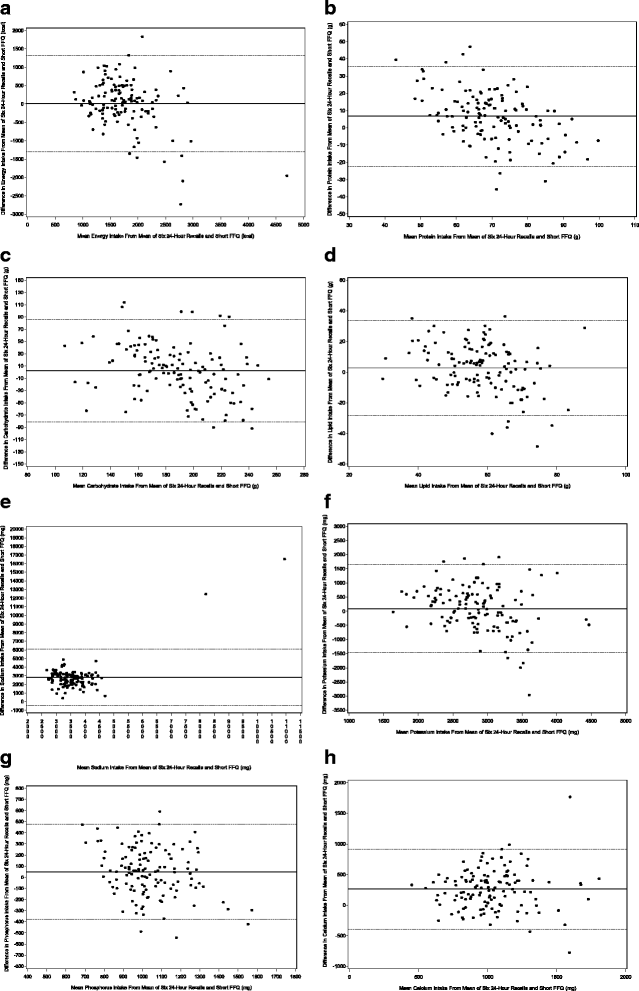Validity and reproducibility of a short food frequency questionnaire among patients with chronic kidney disease
- PMID: 28915857
- PMCID: PMC5599889
- DOI: 10.1186/s12882-017-0695-2
Validity and reproducibility of a short food frequency questionnaire among patients with chronic kidney disease
Abstract
Background: A balanced diet is essential to slowing the progression of chronic kidney disease (CKD) and managing the symptoms. Currently, no tool is available to easily and quickly assess energy and macronutrient intake in patients with non end-stage CKD. We aimed to develop and evaluate the validity and reproducibility of a new short 49-item food frequency questionnaire (SFFQ) adapted to patients with CKD.
Methods: The CKD-REIN study is a prospective cohort that enrolled 3033 patients with moderate or advanced CKD from a national sample of nephrology clinics. A sub-sample of 201 patients completed the SFFQ twice, at a one-year interval and were included in the reproducibility study. During this interval, 127 patients also completed six 24-h recalls and were included in the validity study. Main nutrient and dietary intakes were computed. Validity was evaluated by calculating crude, energy-adjusted and de-attenuated correlation coefficients (CC) between FFQ and the mean of the 24-h recall results. Bland-Altman plots were performed and cross-classification into quintiles of consumption of each nutrient and food group was computed. Reproducibility between the two SFFQs was evaluated by intraclass CC (ICC).
Results: Regarding validity, CC ranged from 0.05 to 0.79 (unadjusted CC, median: 0.40) and 0.10 to 0.59 (de-attenuated CC, median: 0.35) for food group and nutrient intakes, respectively. Five of the most important nutrients of interest in CKD, i.e. protein, calcium, phosphorus, potassium, and sodium had de-attenuated CC of 0.46, 0.43, 0.39, 0.32, and 0.12, respectively. The median of classification into the same or adjacent quintiles was 68% and 65% for food and nutrient intakes, respectively, and ranged from 63% to 69% for the five nutrients mentioned before. Bland-Altman plots showed good agreement across the range of intakes. ICC ranged from 0.18 to 0.66 (median: 0.46).
Conclusions: The CKD-REIN SFFQ showed acceptable validity and reproducibility in a sample of patients with CKD, notably for CKD nutrients of importance. It can now be used in large-scale epidemiological studies to easily assess the relations between diet and CKD outcomes as well as in clinical routine. It may also serve as a basis for the development of FFQs in international CKD cohort networks.
Keywords: Chronic kidney disease; Diet; Dietary assessment; Reproducibility; Short food frequency questionnaire; Validity.
Conflict of interest statement
Ethics approval and consent to participate
This study was conducted according to the guidelines laid down in the Declaration of Helsinki and all procedures involving human subjects were approved by the French National Commission for Computerized Data and Individual Freedom (CNIL). All participants signed a letter of informed consent to allow their data to be stored, as required by the CNIL.
Consent for publication
Not applicable.
Competing interests
The authors declare that they have no competing interests.
Publisher’s Note
Springer Nature remains neutral with regard to jurisdictional claims in published maps and institutional affiliations.
Figures

References
-
- KDIGO 2012. Clinical practice guideline for the evaluation and Management of Chronic Kidney Disease. Kidney International Supplements (2013). 2013;3(1):73-90. Chapter 3. - PubMed
-
- Academy of Nutrition and Dietetics. Chronic Kidney Disease (CKD) Guideline (2010). Available from: www.andeal.org/topic.cfm?menu=5303&cat=3927. Accesed 22 July 2017.
MeSH terms
LinkOut - more resources
Full Text Sources
Other Literature Sources
Medical
Molecular Biology Databases

